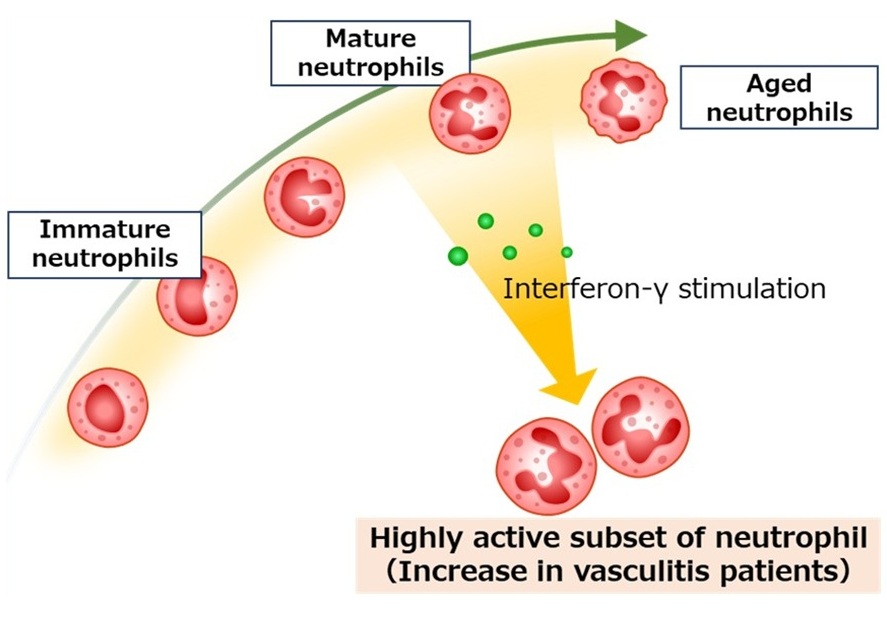Blood Test Determines Esophageal Cancer Patient Treatment Options
|
By LabMedica International staff writers Posted on 21 Oct 2014 |

Image: A fluorescent proximity ligation assay of protein-protein interactions (Photo courtesy of Abnova).
A blood test that may be beneficial in indicating neoadjuvant treatment regimens for patients with esophageal squamous cell carcinoma has been introduced.
The blood test measures levels of two proteins found in the body, vascular endothelial growth factor-A (VEGF-A) and transforming growth factor-β1 (TGF-β1), indicate patients’ pathological response, and disease-free survival rates.
Scientists at the National Taiwan University Hospital (Taipei City, Taiwan) evaluated serum samples of 103 total patients with esophageal squamous cell carcinoma (ESCC) from 2004 to 2013. All patients received preoperative taxane-/5-fluorouracil-based chemotherapy (CCRT) and 40 gray (Gy) dose of radiation therapy prior to esophagectomy, the surgical removal of a part of the esophagus.
Serum samples were collected from patients before and within one month of completion of CCRT. The team used a proximity ligation assay (PLA) technique to screen for 15 serum biomarkers in 79 patients to evaluate the biomarkers’ association with pathological tumor regression on surgery and survival. The biomarkers significantly associated with pathological response (PathR) and survival rates were further analyzed by traditional enzyme-linked, immunosorbent assay (ELISA) to confirm initial biomarker findings by PLA in the total group of 103 patients.
The investigators found that patients with high VEGF-A were less likely to achieve complete tumor regression or a decrease in the size of a tumor or in the extent of cancer in the body, and that the survival rates were lower among patients who had high VEGF-A and high TGF-β1 levels before treatment. On ELISA, both pre- and post-CCRT VEGF-A levels were significantly correlated with PathR. Patients with pretreatment VEGF-A of less than 250 pg/mL showed a statistically significant pathologically complete response after CCRT (57.1%, or 20/35) compared to patients with VEGF-A of more than 250 pg/mL (26.5% or 18/68).
Jason Cheng, MD, the senior author of the study said, “Through the utilization of a specific blood test of serum biomarkers, we could potentially predict if a patient will have a favorable pathological response and outcome before radiotherapy. Treatment could be tailored for patients in order to achieve better outcomes and/or fewer side effects. Our study showed that the serum levels of VEGF-A and TGF-β1 were significant only before treatment. This would allow us to individualize the neoadjuvant treatment regimens based on the pretreatment serum levels of VEGF-A and TGF-β1.” The study was presented on September 14, 2014, at the American Society for Radiation Oncology’s (ASTRO’s) 56th Annual Meeting, held in San Francisco (CA, USA).
Related Links:
National Taiwan University Hospital
The blood test measures levels of two proteins found in the body, vascular endothelial growth factor-A (VEGF-A) and transforming growth factor-β1 (TGF-β1), indicate patients’ pathological response, and disease-free survival rates.
Scientists at the National Taiwan University Hospital (Taipei City, Taiwan) evaluated serum samples of 103 total patients with esophageal squamous cell carcinoma (ESCC) from 2004 to 2013. All patients received preoperative taxane-/5-fluorouracil-based chemotherapy (CCRT) and 40 gray (Gy) dose of radiation therapy prior to esophagectomy, the surgical removal of a part of the esophagus.
Serum samples were collected from patients before and within one month of completion of CCRT. The team used a proximity ligation assay (PLA) technique to screen for 15 serum biomarkers in 79 patients to evaluate the biomarkers’ association with pathological tumor regression on surgery and survival. The biomarkers significantly associated with pathological response (PathR) and survival rates were further analyzed by traditional enzyme-linked, immunosorbent assay (ELISA) to confirm initial biomarker findings by PLA in the total group of 103 patients.
The investigators found that patients with high VEGF-A were less likely to achieve complete tumor regression or a decrease in the size of a tumor or in the extent of cancer in the body, and that the survival rates were lower among patients who had high VEGF-A and high TGF-β1 levels before treatment. On ELISA, both pre- and post-CCRT VEGF-A levels were significantly correlated with PathR. Patients with pretreatment VEGF-A of less than 250 pg/mL showed a statistically significant pathologically complete response after CCRT (57.1%, or 20/35) compared to patients with VEGF-A of more than 250 pg/mL (26.5% or 18/68).
Jason Cheng, MD, the senior author of the study said, “Through the utilization of a specific blood test of serum biomarkers, we could potentially predict if a patient will have a favorable pathological response and outcome before radiotherapy. Treatment could be tailored for patients in order to achieve better outcomes and/or fewer side effects. Our study showed that the serum levels of VEGF-A and TGF-β1 were significant only before treatment. This would allow us to individualize the neoadjuvant treatment regimens based on the pretreatment serum levels of VEGF-A and TGF-β1.” The study was presented on September 14, 2014, at the American Society for Radiation Oncology’s (ASTRO’s) 56th Annual Meeting, held in San Francisco (CA, USA).
Related Links:
National Taiwan University Hospital
Latest Pathology News
- Sensitive and Specific DUB Enzyme Assay Kits Require Minimal Setup Without Substrate Preparation
- World’s First AI Model for Thyroid Cancer Diagnosis Achieves Over 90% Accuracy
- Breakthrough Diagnostic Approach to Significantly Improve TB Detection
- Rapid, Ultra-Sensitive, PCR-Free Detection Method Makes Genetic Analysis More Accessible
- Spit Test More Accurate at Identifying Future Prostate Cancer Risk
- DNA Nanotechnology Boosts Sensitivity of Test Strips
- Novel UV and Machine Learning-Aided Method Detects Microbial Contamination in Cell Cultures
- New Error-Corrected Method to Help Detect Cancer from Blood Samples Alone
- "Metal Detector" Algorithm Hunts Down Vulnerable Tumors
- Novel Technique Uses ‘Sugar’ Signatures to Identify and Classify Pancreatic Cancer Cell Subtypes
- Advanced Imaging Reveals Mechanisms Causing Autoimmune Disease
- AI Model Effectively Predicts Patient Outcomes in Common Lung Cancer Type
- AI Model Predicts Patient Response to Bladder Cancer Treatment
- New Laser-Based Method to Accelerate Cancer Diagnosis
- New AI Model Predicts Gene Variants’ Effects on Specific Diseases
- Powerful AI Tool Diagnoses Coeliac Disease from Biopsy Images with Over 97% Accuracy
Channels
Clinical Chemistry
view channel
‘Brilliantly Luminous’ Nanoscale Chemical Tool to Improve Disease Detection
Thousands of commercially available glowing molecules known as fluorophores are commonly used in medical imaging, disease detection, biomarker tagging, and chemical analysis. They are also integral in... Read more
Low-Cost Portable Screening Test to Transform Kidney Disease Detection
Millions of individuals suffer from kidney disease, which often remains undiagnosed until it has reached a critical stage. This silent epidemic not only diminishes the quality of life for those affected... Read more
New Method Uses Pulsed Infrared Light to Find Cancer's 'Fingerprints' In Blood Plasma
Cancer diagnoses have traditionally relied on invasive or time-consuming procedures like tissue biopsies. Now, new research published in ACS Central Science introduces a method that utilizes pulsed infrared... Read moreMolecular Diagnostics
view channel
Revolutionary Blood Test Detects 30 Different Types of Cancers with 98% Accuracy
With cancer expected to become the leading cause of global mortality by 2030, early detection remains the most effective strategy to reduce death rates. Current screening methods only cover five types... Read more
Simple Blood Test Better Predicts Heart Disease Risk
Cardiovascular diseases (CVDs) are the primary cause of death worldwide. A large proportion of these cases could be prevented by addressing lifestyle and environmental factors such as smoking, poor diet,... Read moreHematology
view channel
New Scoring System Predicts Risk of Developing Cancer from Common Blood Disorder
Clonal cytopenia of undetermined significance (CCUS) is a blood disorder commonly found in older adults, characterized by mutations in blood cells and a low blood count, but without any obvious cause or... Read more
Non-Invasive Prenatal Test for Fetal RhD Status Demonstrates 100% Accuracy
In the United States, approximately 15% of pregnant individuals are RhD-negative. However, in about 40% of these cases, the fetus is also RhD-negative, making the administration of RhoGAM unnecessary.... Read moreImmunology
view channel
Stem Cell Test Predicts Treatment Outcome for Patients with Platinum-Resistant Ovarian Cancer
Epithelial ovarian cancer frequently responds to chemotherapy initially, but eventually, the tumor develops resistance to the therapy, leading to regrowth. This resistance is partially due to the activation... Read more
Machine Learning-Enabled Blood Test Predicts Immunotherapy Response in Lymphoma Patients
Chimeric antigen receptor (CAR) T-cell therapy has emerged as one of the most promising recent developments in the treatment of blood cancers. However, over half of non-Hodgkin lymphoma (NHL) patients... Read moreMicrobiology
view channel
Handheld Device Delivers Low-Cost TB Results in Less Than One Hour
Tuberculosis (TB) remains the deadliest infectious disease globally, affecting an estimated 10 million people annually. In 2021, about 4.2 million TB cases went undiagnosed or unreported, mainly due to... Read more
New AI-Based Method Improves Diagnosis of Drug-Resistant Infections
Drug-resistant infections, particularly those caused by deadly bacteria like tuberculosis and staphylococcus, are rapidly emerging as a global health emergency. These infections are more difficult to treat,... Read more
Breakthrough Diagnostic Technology Identifies Bacterial Infections with Almost 100% Accuracy within Three Hours
Rapid and precise identification of pathogenic microbes in patient samples is essential for the effective treatment of acute infectious diseases, such as sepsis. The fluorescence in situ hybridization... Read moreTechnology
view channel
Disposable Microchip Technology Could Selectively Detect HIV in Whole Blood Samples
As of the end of 2023, approximately 40 million people globally were living with HIV, and around 630,000 individuals died from AIDS-related illnesses that same year. Despite a substantial decline in deaths... Read more
Pain-On-A-Chip Microfluidic Device Determines Types of Chronic Pain from Blood Samples
Chronic pain is a widespread condition that remains difficult to manage, and existing clinical methods for its treatment rely largely on self-reporting, which can be subjective and especially problematic... Read more
Innovative, Label-Free Ratiometric Fluorosensor Enables More Sensitive Viral RNA Detection
Viruses present a major global health risk, as demonstrated by recent pandemics, making early detection and identification essential for preventing new outbreaks. While traditional detection methods are... Read moreIndustry
view channel
Cepheid and Oxford Nanopore Technologies Partner on Advancing Automated Sequencing-Based Solutions
Cepheid (Sunnyvale, CA, USA), a leading molecular diagnostics company, and Oxford Nanopore Technologies (Oxford, UK), the company behind a new generation of sequencing-based molecular analysis technologies,... Read more
Grifols and Tecan’s IBL Collaborate on Advanced Biomarker Panels
Grifols (Barcelona, Spain), one of the world’s leading producers of plasma-derived medicines and innovative diagnostic solutions, is expanding its offer in clinical diagnostics through a strategic partnership... Read more









 Assay.jpg)











